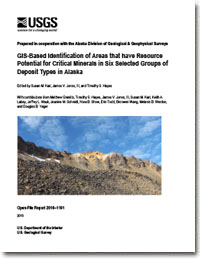GIS-based identification of areas that have resource potential for critical minerals in six selected groups of deposit types in Alaska
Links
- Document: Report (2.6 MB pdf)
- Plate: Plates 1–12 (32.6 MB pdf) 12 tabloid-sized plates, packaged into a single PDF file
- Appendixes:
- Appendix A (63 KB xlsx) Stream-sediment-geochemistry summary statistics and percentile-value cutoffs
- Appendix B (72 KB pdf) Igneous-rock-geochemistry peer-reviewed-literature sources
- Appendix C (60 KB xlsx) Alaska Resource Data File (ARDF) mineral-deposit-keyword-and-scoring templates
- Appendix D (18 KB xlsx) Lithology-keyword search terms for U.S. Geological Survey's "Geologic Map of Alaska"
- Appendix E - Results Geodatabase (411.6 MB zip) Scoring results for HUC analysis of selected deposit groups (in Excel spreadsheet and geodatabase format, with mxd for viewing)
- Appendix E - Results Shapefile (878.7 MB zip) Scoring results for HUC analysis of selected deposit groups (in shapefile format, for users that cannot use the geodatabase)
- Appendix E - Source Data Geodatabase (2.16 GB zip) Source datasets and Python scripts for HUC analysis of selected deposit groups (in geodatabase format, with mxd for viewing)
- Appendix E - Source Data Shapefile (308.4 MB zip) Source datasets for HUC analysis of selected deposit groups (in shapefile format, for users that cannot use the geodatabases)
- Metadata: Metadata (219 KB zip) Metadata for results and source datasets
- Download citation as: RIS | Dublin Core
Abstract
Alaska has considerable potential for undiscovered mineral resources. This report evaluates potential for undiscovered critical minerals in Alaska. Critical minerals are those for which the United States imports more than half of its total supply and which are largely derived from nations that cannot be considered reliable trading partners. In this report, estimated resource potential and certainty for the state of Alaska are analyzed and mapped for the following six selected mineral deposit groups that may contain one or more critical minerals: (1) rare earth elements-thorium-yttrium-niobium(-uranium-zirconium) [REE-Th-Y-Nb(-U-Zr)] deposits associated with peralkaline to carbonatitic igneous intrusive rocks; (2) placer and paleoplacer gold (Au) deposits that in some places might also produce platinum group elements (PGE), chromium (Cr), tin (Sn), tungsten (W), silver (Ag), or titanium (Ti); (3) platinum group elements(-cobalt-chromium-nickel-titanium-vanadium) [PGE(-Co-Cr-Ni-Ti-V)] deposits associated with mafic to ultramafic intrusive rocks; (4) carbonate-hosted copper(-cobalt-silver-germanium-gallium) [Cu(-Co-Ag-Ge-Ga)] deposits; (5) sandstone-hosted uranium(-vanadium-copper) [U(-V-Cu)] deposits; and (6) tin-tungsten-molybdenum(-tantalum-indium-fluorspar) [Sn-W-Mo(-Ta-In-fluorspar)] deposits associated with specialized granites.
This study used a data-driven, geographic information system (GIS)-implemented method to identify areas that have mineral resource potential in Alaska. This method systematically and simultaneously analyzes geoscience data from multiple geospatially referenced datasets and uses individual subwatersheds (12-digit hydrologic units) as the spatial unit of classification. The final map output uses a red, yellow, green, and gray color scheme to portray estimated relative potential (High, Medium, Low, Unknown) for each of the six groups of mineral deposit types, and it indicates the relative certainty (High, Medium, Low) of that estimate for each 12-digit hydrologic unit through color shading. Accompanying tables describe the data layers employed to score favorability for the presence of each mineral deposit group, the values assigned for specific analysis parameters, and the relative weighting of each data layer that contributes to estimated measures of potential and certainty. Core datasets used include the Alaska Geochemical Database, Version 2.0 (AGDB2); the Alaska Division of Geological & Geophysical Surveys (ADGGS) web-based geochemical database; the digital “Geologic Map of Alaska;” the Alaska Resource Data File (ARDF); and aerial gamma-ray surveys flown as part of the National Uranium Resource Evaluation (NURE) Program by the U.S. Department of Energy.
Maps accompanying this report illustrate the scores for estimated mineral resource potential for the six deposit groups for the state of Alaska. Areas that have known potential, as well as new areas that were not previously known to have potential, for the targeted minerals and deposit groups are identified and described. Numerous areas in Alaska, some of them large, have high potential for one or more of the selected groups of deposit types within Alaska.
Contributors
Matthew Granitto, Timothy S. Hayes, James V. Jones, III, Susan M. Karl, Keith A. Labay, Jeffrey L. Mauk, Jeanine M. Schmidt, Nora B. Shew, Erin Todd, Bronwen Wang, Melanie B. Werdon, and Douglas B. Yager
Suggested Citation
Karl, S.M., Jones, J.V., III, and Hayes, T.S., eds., 2016, GIS-based identification of areas that have resource potential for critical minerals in six selected groups of deposit types in Alaska: U.S. Geological Survey Open-File Report 2016–1191, 99 p., 5 appendixes, 12 plates, scale 1:10,500,000, https://dx.doi.org/10.3133/ofr20161191.
ISSN: 2331-1258 (online)
Study Area
Table of Contents
- Abstract
- Introduction
- Chapter 1. REE-Th-Y-Nb(-U-Zr) Deposits Associated with Peralkaline to Carbonatitic Intrusive Rocks
- Chapter 2. Placer and Paleoplacer Gold (Au) Deposits
- Chapter 3. PGE(-Co-Cr-Cu-Ni-Ti-V) Deposits Associated with Mafic to Ultramafic Intrusive Rocks
- Chapter 4. Carbonate-Hosted Cu(-Co-Ag-Ge-Ga) Deposits
- Chapter 5. Sandstone-Hosted U(-V-Cu) Deposits
- Chapter 6. Sn-W-Mo(-Ta-In-Fluorspar) Deposits Associated with Specialized Granites
- Summary
- Data Resources
- References Cited
| Publication type | Report |
|---|---|
| Publication Subtype | USGS Numbered Series |
| Title | GIS-based identification of areas that have resource potential for critical minerals in six selected groups of deposit types in Alaska |
| Series title | Open-File Report |
| Series number | 2016-1191 |
| DOI | 10.3133/ofr20161191 |
| Publication Date | November 16, 2016 |
| Year Published | 2016 |
| Language | English |
| Publisher | U.S. Geological Survey |
| Publisher location | Reston, VA |
| Contributing office(s) | Alaska Science Center Geology Minerals |
| Description | Report: viii, 99 p.; 12 Plates: 12 p.; 8 Appendixes; Metadata |
| Country | United States |
| State | Alaska |
| Online Only (Y/N) | Y |
| Additional Online Files (Y/N) | Y |


